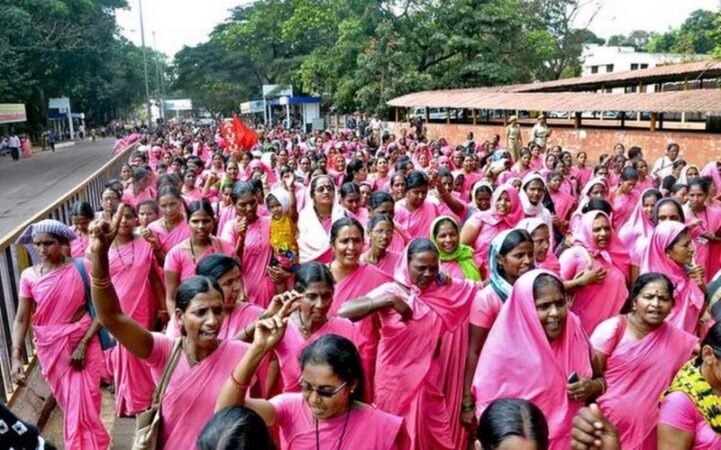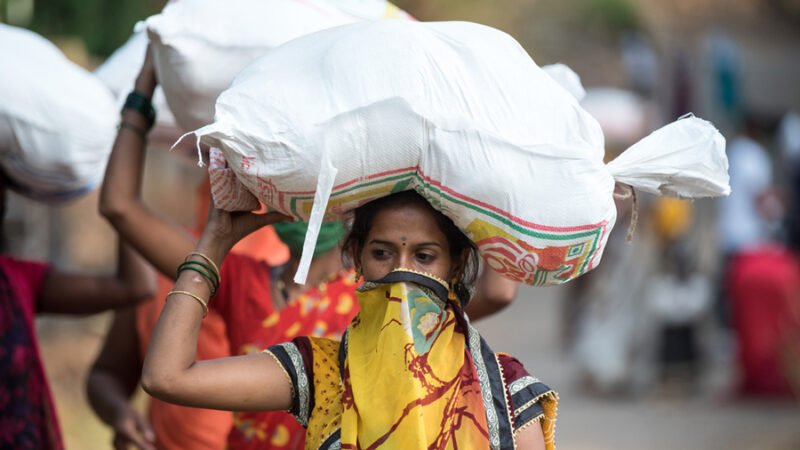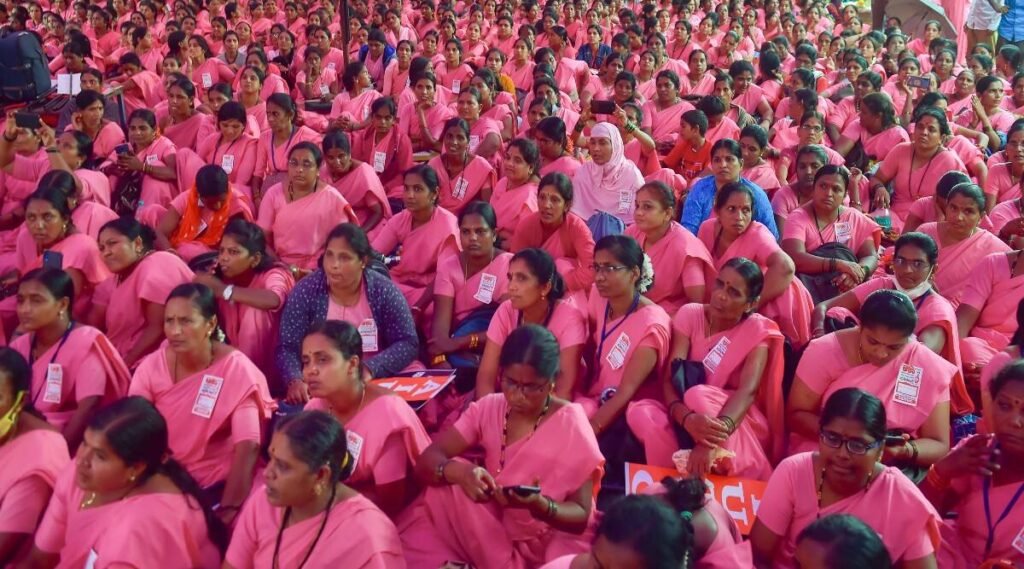Oscillating Lives of Women Workers Between Plight and Protest: Three Years Have Passed, When Will They Get Respite?

The apocalyptic saga of COVID-19 knocked on the doors of the Indian state to hint at its probable arrival, stay and associated assaults on 30th January 2020 when the first case of COVID-19 came up. But the government kept itself blissfully occupied with other events of greater importance –the historic visit of the then United States President Donald Trump, campaigning for upcoming Delhi elections and (mis)managing and (un)handling of Delhi North East Riots. On 11th March 2020, World Health Organisation made a public announcement declaring COVID-19 as a global pandemic. Even this crucial piece of warning got submerged under the mess created around the toppled Congress government in Madhya Pradesh and the politically charged chaos that followed. Unfortunately, till then, the virus got proliferated and started claiming lives. Finally, on 24th March 2020, our Prime Minister stressfully though comfortingly announced the most abrupt, unprepared and harshest lockdown in the world with generous four-hour notice, which brought lives of privileged in their homes and lives of poor migrant labourers on the roads.
If one happens to read the book The Road Less Travelled by M. Scott Peck, its first few lines will caution, “Life is Difficult” and would be followed by how one tends to make one’s life difficult by simply closing eyes to problems. But isn’t this choice of closing eyes essentially classist? Especially in the present scenario, because some had the privilege, choice and resources to close their eyes to the pandemic, the others had to step on the road less travelled. As the cities and the state ruthlessly abandoned its over one crore migrant workers, its makers, left them no option other than to embark on their journeys to their villages, barefoot, for bare survival. Some issues that plagued the poorly implemented lockdown were the barbarous treatment given to workers, denial of rights and legal protection which made the air smell like that of emergency, altering labour laws rendering workers as slaves in the hands of corporate and capital and more. One such issue which will be addressed here is the total absence of a gender lens in the whole scene. The worst sufferers or better say sufferers of dual degree were women. But as time passed, they came out to be the strongest voices of dissent and resistance, irrespective of media coverage, place in public policy formulation or representation in fancily hollow speeches made by ministers strategically made around elections, across parties they got.

These were the same women who came forward to save the Indian health system when it was experiencing a total breakdown as ASHA (Accredited Social Health Activist), Anganwadi and other scheme workers. Remember the way they were showered with flowers? Perhaps, petals were the only remuneration they got for risking their lives for supporting and treating virus-engrained patients without required gear, going door to door testing for COVID-19 and supplying medicines, working for extremely long hours and at odd hours and were poorly-barely-seldom paid. As the country started slowly recovering from the COVID-19 burns and situations in hospitals were approaching normalcy, these same workers were conveniently removed and abandoned and their conditions have been deteriorating since; with either no or poorly paid jobs amid the rising cost of living. In November 2021 hundreds of women lead a cycle rally supported by students, workers and artists decrying inflation followed and caused by the lockdowns. The rally started from Ramlila Maidan and turned into a public meeting at Turkman Gate.
For the next year, the country saw a chain of protests taking birth from their suffering and the everyday struggle to meet existential everyday needs as being the culturally assigned primary caregivers and secondary workers, whose peak appeared at Jantar Mantar, New Delhi, on 21st November 2022 where the All India Women Scheme Workers’ Protest was organised to demand proper compensation to the families of the scheme workers who died during the pandemic, an end to privatization / NGO-ization of public utility government schemes (NHM, Mid-Day meal, ICDS, etc.), to give them(ASHA, Mid-Day meal, Anganwadi, etc.) the status of government employees along with a fixed monthly salary of Rs. 28,000 for all scheme workers at the national level, guarantee proper social security including pension among others.
A report by the Centre for Sustainable Employment at Azim Premji University brought out that during the first lockdown in 2020, 47% of women lost their jobs and could not return to work even by the end of the year. The situation of informal women workers has been even worse. Meanwhile, their unpaid care work grew by nearly 30%. Not only household were surviving on the unacknowledged, unpaid and invisible care work of women but even the Indian state by large absorbed them into the crisis-ridden healthcare system and conveniently showed them the path back home afterwards. Indeed, the COVID-19 crisis was a crisis of care. Additionally, studies brought out that migrant women workers in particular had to compromise with their basic hygiene and sanitation needs owing to loss of livelihood and the resulting debt. “I was using pads during menstruation. We are not eating enough now. Then how can I think of pads? I am using clothes now” recounts a domestic help worker of Gurugram who had to migrate back to Bihar post-lockdown. Another from Uttar Pradesh explains how even before the lockdown they had a problem with toilet access and the condition worsened by lockdown. She explained, “After lockdown, as all the people stay at home, the toilets become very crowded. It is not safe. Going to open spaces is also difficult now due to the surveillance of many men who stay at home”.

Another set of women workers affected grossly by the horrendous lockdown were domestic help workers whose job fall under the category of unskilled and informal one, leaving them with no socio-legal support, redressal mechanism and constitutional rights as the state continues to exclude domestic workers from the list of scheduled employment under the Minimum Wages Act, 1984. Rekha Devi who works as a domestic help worker in the Nizamuddin area of Delhi had to go back to her village Kashipur, Uttarakhand, taking her two kids along as she could not afford the rent and other expenses. She laments, “Even reaching home appeared as a dream. I thought three of us would not be able to reach our home alive”. When asked about the support and help received from her family and the government she said, “Nobody bothers about a widow, my husband died of cancer a few years back. After that, my in-laws threw me out. Somehow I managed to reach seher with my children and things were going well. Only 6-7 months back I took a pakka room on rent all by myself. My children were going to nearby government school. Now I am again from where I have begun. Everything is so expensive and we have no money. There’s no happiness for women like us”. The sheer lack of data and recognition of their work made them invisible enough in government relief measures. Moreover, due to the ambiguity around their work, they are conveniently pushed to the margins in the basic laws that guarantee job security and welfare like Maternity Benefit Act, 1961; Workmen’s Compensation Act, 1923; Inter State Migrant Workers Act, 1979 and so forth.
Women migrant workers in particular can be seen to be caught in the vicious cycle of precarity and pain even after three long and dreadful years of lockdown. Where men found it easier to re-migrate to urban spaces to overcome the harms, women seem to have been made to stay back. Both the processes, remigration and reintegration into the economy have been extremely difficult for women, further adding to their vulnerability which is, yet again, conveniently been submerged with other events of greater importance like India’s presidency of G20 and the consequent bulldozer beautification drive, Oscar award celebrations among others. Presently as we read this issue, NREGA workers are protesting at Jantar Mantar, Delhi, under the banner of “NREGA Sangharsh Morcha”. NREGA (National Rural Employment Guarantee Act) during and after pandemic came out as an essential safety net, especially for migrant workers to partially compensate for their lost means of income. The agitation is strongly led by women workers hailing from across the country and they are determined to continue it for 100 days to hold the government accountable for unpaid wages, rising unemployment and repeal of the NMMS App.


















